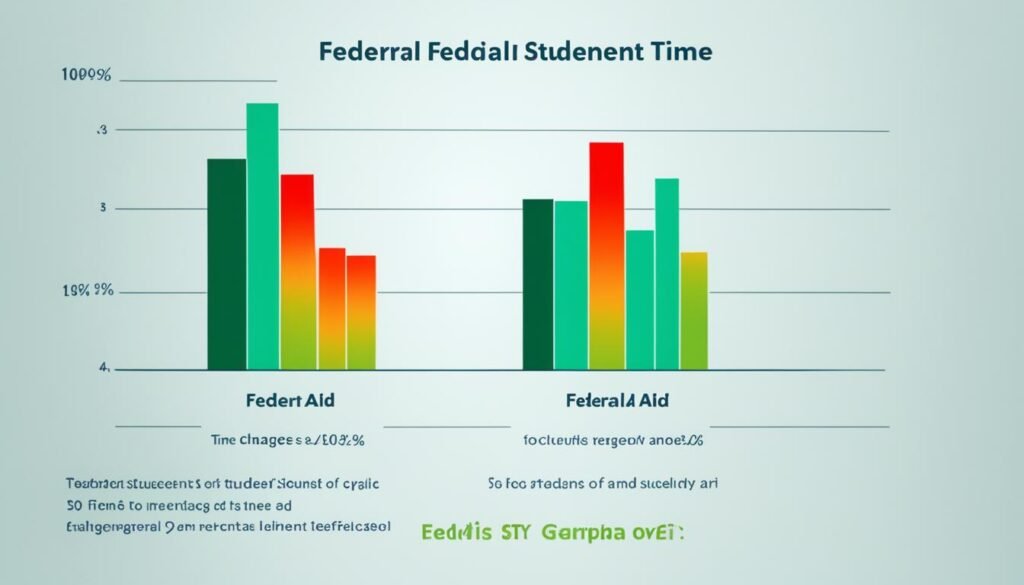Welcome to the insider’s guide on how to navigate the eligibility requirements for federal student loans. Whether you’re a first-time borrower or looking to make the most of your financial aid options, understanding the criteria for loan eligibility is crucial. In this section, we will explore key factors that determine eligibility, including completing the Free Application for Federal Student Aid (FAFSA), income-driven repayment options, loan forgiveness programs, and the role of a qualified cosigner.
Completing the Free Application for Federal Student Aid (FAFSA) is the first step in determining your eligibility for federal student loans, scholarships and grants, as well as other forms of financial aid. The FAFSA assesses your financial need based on factors such as income, assets, and family size. By submitting the FAFSA, you can gain access to a wide range of federal loan programs, including direct loans and PLUS loans.
Income-driven repayment options provide borrowers with greater flexibility in managing their loan payments. These programs calculate your monthly payment amount based on a percentage of your discretionary income, ensuring that your payments remain affordable and manageable. Additionally, income-driven repayment plans offer the potential for loan forgiveness after a certain period of time.
“Loan forgiveness programs are an excellent opportunity for borrowers to secure relief from their federal loan debt.”
When evaluating your eligibility for federal student loans, it’s important to consider the impact of loan forgiveness programs. These programs, such as the Public Service Loan Forgiveness program, provide opportunities for borrowers who work in certain public service jobs to have their loans forgiven after a designated period of service. By qualifying for these programs, you can greatly alleviate the burden of student loan debt.
A qualified cosigner can play a crucial role in securing student loan eligibility. For borrowers who may not meet the necessary credit or income requirements on their own, having a cosigner who meets these qualifications can increase the chances of loan approval. It’s important to note that both federal and private student loans offer the option to have a cosigner, but requirements and benefits may vary.
Understanding the eligibility requirements for federal student loans empowers borrowers to make informed decisions regarding their financial aid options. By considering factors such as completing the FAFSA, income-driven repayment plans, loan forgiveness programs, and the role of a qualified cosigner, you can navigate the loan application process with confidence and secure the financial assistance needed to pursue your educational goals.
The Insider’s Guide Tip:
If you need assistance with your federal student loans or have questions about eligibility, be sure to reach out to your school’s financial aid office. Financial aid advisors are equipped to provide personalized guidance and support throughout the student loan application process.
Meeting the Criteria for Private Student Loans
When federal student loans fall short of covering your educational expenses, considering a private student loan can be a viable option. Private student loans offer additional funding to bridge the gap, but it’s essential to understand the eligibility criteria to make an informed decision.
To be eligible for a private student loan, certain factors play a significant role. Let’s explore these key factors:
Creditworthiness
Private lenders evaluate your credit history and credit score to assess your creditworthiness. A good credit score demonstrates your ability to manage debt responsibly and may help you secure a loan with favorable terms, such as a lower interest rate.
Loan Amount
The loan amount for a private student loan will depend on the cost of attendance at your chosen school. Private loans can cover various educational expenses, including tuition, books, room and board, and other fees.
Eligibility
Each private lender sets its own eligibility requirements. These requirements may include factors such as income, employment history, and credit history. Make sure to review and compare the eligibility criteria of different lenders to find the best fit for your circumstances.
Repayment
Private student loans typically require repayment to begin while you’re still in school, unlike federal loans that offer a grace period. Understanding the repayment terms, including the monthly payment amount and repayment options, is crucial when considering a private student loan.
Cosigner Options
Many private lenders offer the option to apply with a cosigner who’s a U.S. citizen or permanent resident. A cosigner with a strong credit history can increase your chances of approval and potentially help you secure a lower interest rate on your loan.
When exploring private student loan options, it’s important to consider the fees, interest rates, repayment terms, and benefits offered by different lenders. Comparing multiple lenders can help you find the best loan for your needs.
Keep in mind that private student loans should be considered after exhausting all federal loan options, as federal loans typically offer more favorable terms, borrower protections, and loan repayment options. Nevertheless, if you find yourself in need of additional funding, private student loans can be a valuable resource.
| Loan Features | Private Student Loans | Federal Student Loans |
|---|---|---|
| Eligibility Criteria | Based on creditworthiness, income, and other factors | Based on financial need and completing the FAFSA |
| Interest Rates | Varies by lender, based on creditworthiness | Fixed rates set by the government |
| Repayment Terms | Varies by lender, repayment begins while in school | Grace period after leaving school, flexible repayment options |
| Loan Limits | Varies by lender and cost of attendance | Set by federal loan programs |
| Borrower Protections | Varies by lender | Offered by federal loan programs |
“When considering private student loans, it’s important to carefully evaluate the terms and conditions. Compare different options, apply with a cosigner if necessary, and always consider federal loan options first.” – Student Loans Editor
Understanding the Factors That Influence Student Loan Eligibility
When it comes to student loan eligibility, several factors come into play. By understanding these factors, you can navigate the loan application process with confidence and make informed decisions about your education financing options.
Outstanding Student Debt
One significant factor that can impact your eligibility for student loans is your existing student debt. Lenders and financial institutions may consider your current loan balance when determining your ability to take on additional debt. It is important to manage your existing student loans responsibly and make timely payments to improve your eligibility for future borrowing.
Cost of Attendance
The cost of attendance at your chosen educational institution also plays a crucial role in determining your student loan eligibility. Lenders typically consider the total cost, including tuition, fees, books, and living expenses, to assess your financial need and determine how much you can borrow.
Loan Forgiveness Programs
Loan forgiveness programs, both federal and private, can impact your eligibility for certain student loans. These programs offer relief options that can reduce your loan burden, but they often come with eligibility requirements. It is essential to understand the specific criteria for loan forgiveness and determine if you qualify based on your field of study or profession.
Income Requirements
Your personal income or your parents’ income may be factors that affect your eligibility for student loans. Some federal aid options, such as subsidized loans, consider your financial need when determining eligibility. Additionally, certain repayment options like income-driven repayment plans may require specific income thresholds to qualify.
Loan Payments and Monthly Income
When reviewing loan applications, lenders also assess your ability to make loan payments based on your monthly income. They consider the ratio between your monthly income and the loan payments you would be responsible for. Demonstrating a stable income and a reasonable ability to repay the loan can increase your eligibility.
Specific Loan Options for Health Professions
Professions in the healthcare field, such as doctors, nurses, and dentists, often have access to specialized loan options. Health professions loans designed for these fields may have unique eligibility requirements, repayment terms, and forgiveness programs. Understanding these specific loan options is essential for healthcare students and professionals.
Federal Aid Options
Federal student loans provide various financial aid options, each with its own eligibility criteria. By researching and understanding these federal aid programs, you can identify the loans for which you may qualify. Examples of federal student loans include Direct Loans and PLUS loans.
Financial Need and Repayment Options
Your financial need, as determined by your FAFSA (Free Application for Federal Student Aid), can influence your student loan eligibility. Additionally, exploring different repayment options can help you plan and budget for loan payments based on your financial capabilities.

Private Student Loans
Unlike federal loans, private student loans are issued by private financial institutions and have their own eligibility requirements. These requirements can vary widely, including factors like credit history, income, and employment status. Understanding the criteria for private student loans is essential when considering this financing option.
By comprehending the various factors that influence student loan eligibility, you can navigate the borrowing process effectively. It is important to research and gather all the necessary information to make informed decisions about federal and private student loans, repayment options, and potential loan forgiveness programs.
Strategies to Maximize Your Federal Student Aid Eligibility
When it comes to financing your education, federal student aid can play a crucial role in helping you achieve your academic goals. However, navigating the criteria to qualify for federal student loans can be overwhelming. In this section, we will provide you with strategies to maximize your federal student aid eligibility so you can secure the financial support you need.
Complete the FAFSA Accurately and On Time
The Free Application for Federal Student Aid (FAFSA) is the key to unlocking federal student aid opportunities. It’s important to complete the FAFSA accurately and submit it on time to ensure you are considered for federal grants, scholarships, work-study, and loans. Be sure to gather all the necessary documents and double-check your information before submitting your application.
Understand the Different Types of Federal Student Aid
Federal student aid typically comes in the form of grants, loans, and work-study programs. Grants are awarded based on financial need and do not require repayment. Loans, on the other hand, need to be repaid, but they often come with lower interest rates and more favorable repayment terms compared to private loans. Work-study programs provide part-time job opportunities that help you earn money for educational expenses.
Explore Alternative Funding Options
In addition to federal student aid, there are other funding options you can explore to supplement your financial need. Scholarships and grants are excellent sources of free money that you don’t need to repay. Research and apply for scholarships that align with your academic achievements, extracurricular activities, and personal background. These additional funds can help reduce your reliance on student loans.
Consider a Qualified Cosigner
If you are a new student or if you have multiple student loans, you may find it challenging to meet the financial need requirements on your own. In such cases, a qualified cosigner with a stable income and good credit history can help strengthen your loan application and increase your chances of approval. A cosigner may also qualify you for lower interest rates and more favorable loan terms.
By following these strategies, you can enhance your federal student aid eligibility and secure the financial resources necessary to pursue higher education. Remember to stay proactive and explore all available options, including federal and private loans, scholarships, and grants. Understanding how student loans work and creating a repayment plan will also ensure you can manage your finances responsibly during and after your educational journey.
| Strategies to Maximize Federal Student Aid Eligibility |
|---|
| Complete the FAFSA accurately and on time |
| Understand the different types of federal student aid |
| Explore alternative funding options like scholarships and grants |
| Consider a qualified cosigner if needed |
| Create a repayment plan and manage your finances responsibly |

Calculating Loan Amount and Exploring Repayment Options
When considering student loans, it’s important to calculate the loan amount you need and explore various repayment options. By understanding these aspects, you can make informed decisions about borrowing and plan for successful loan repayment.
Determining the Loan Amount
Before applying for a loan, it’s crucial to assess your financial needs and determine the loan amount required. Consider your tuition fees, living expenses, and other educational costs to arrive at an accurate loan amount. Keep in mind that it’s wise to borrow only what you need to minimize debt burdens in the future.
Additionally, take into account any scholarships and grants you may have received, as these can help reduce the required loan amount. By maximizing non-loan sources of funding, you can minimize the overall financial burden related to your education.
Exploring Repayment Options
Once you have determined the loan amount, it’s important to explore different repayment options. Repayment plans can significantly impact the total cost of your loan, so it’s essential to find the most suitable option for your financial situation.
The repayment plan you choose will determine the monthly payment amount, the interest rate, and the length of your loan term. Here are a few common repayment options:
- Standard Repayment: This plan involves fixed monthly payments over a set period, usually 10 years. It’s a straightforward option but may result in higher monthly payments.
- Income-Driven Repayment: These plans adjust your monthly payment based on your income, making them more flexible and affordable. Examples include Income-Based Repayment (IBR), Pay As You Earn (PAYE), and Revised Pay As You Earn (REPAYE).
- Graduated Repayment: This plan starts with lower monthly payments that increase over time. It’s beneficial for borrowers who expect their income to grow steadily.
- Extended Repayment: This plan extends the repayment term beyond the standard 10-year period, reducing the monthly payment amount. However, it may result in higher overall interest costs.
Furthermore, you may also consider consolidating your loans through a Direct Consolidation Loan. This option combines multiple federal student loans into a single loan with a fixed interest rate, making it easier to manage your loan payments.
It’s important to note that repayment options may vary for federal and private loans. Federal student loans typically offer more flexible repayment options, including loan forgiveness programs and income-driven plans. Private student loans, on the other hand, are typically offered with fixed repayment plans that may not offer as many options.

Unlocking Scholarship and Grant Eligibility
Securing scholarships and grants can significantly alleviate the financial burden associated with higher education expenses. In this section, we will explore the eligibility criteria for scholarships and grants, shedding light on the factors that institutions consider when awarding these forms of financial aid.
Financial Need: Demonstrating financial need is often a key requirement for scholarships and grants. Institutions assess your financial situation and determine the amount of aid you may qualify for based on factors such as family income, assets, and expenses.
Academic Achievements: Many scholarships and grants place importance on academic excellence. Maintaining a high grade point average (GPA) and participating in challenging coursework can increase your eligibility for these forms of financial aid.
Extracurricular Activities: Engaging in extracurricular activities demonstrates your commitment to personal growth and community involvement. Scholarships and grants often consider participation in clubs, sports, community service, leadership roles, and other impactful activities.
Other Factors: Institutions may also evaluate additional factors when awarding scholarships and grants. These factors can include demographic criteria, specific talents or skills, intended major or field of study, and unique circumstances.
By understanding the requirements for scholarships and grants, you can take proactive steps to enhance your eligibility. Additionally, it’s crucial to thoroughly research and apply for various scholarship and grant opportunities, both from external organizations and the colleges or universities you plan to attend.
Receiving Financial Aid Award Letters
Once you’ve been accepted into a college or university, you will likely receive a financial aid award letter outlining the scholarships and grants you’ve been awarded, in addition to any other forms of financial aid. These letters provide important details such as the amount of aid, the terms and conditions, and any additional steps required to accept the award.
It’s crucial to carefully review these letters, as they will help you understand the extent of your financial aid package and any remaining costs you’ll be responsible for. If you have questions or need clarification, don’t hesitate to reach out to the college or university’s financial aid office for assistance.
Next, we’ll explore student loan eligibility and how to navigate the application process to secure the necessary funding for your education.
Navigating the Private Student Loan Application Process
When seeking financial aid for higher education, private student loans can be a viable option to cover the cost of tuition, books, and other expenses. To apply for a private student loan, it’s essential to understand the process involved and gather the necessary documents. By following these steps and tips, you can navigate the private student loan application process smoothly and find the right loan option to meet your needs.
Gather the Required Documents
Before applying for a private student loan, it’s important to gather the necessary documents that lenders typically require. These documents may include:
- Proof of income or employment
- Bank statements
- Proof of enrollment or acceptance into an educational institution
- Personal identification documents
- Academic transcripts
Having these documents ready can expedite the application process and help lenders assess your eligibility for a private student loan.
Research and Compare Loan Options
Private student loans come in a variety of forms, with different interest rates, repayment terms, and benefits. It’s crucial to research and compare loan options from various financial institutions. Consider factors such as interest rates, repayment plans, loan limits, and any additional benefits or perks that lenders may offer.
Use online resources, such as loan comparison websites, to easily compare interest rates and terms. Additionally, reach out to your financial aid office or consult with a student loans expert to gather more information and insights.
Also Read : Unlock Your Vehicle: Convenient Auto Loan Application
Apply for a Private Student Loan
Once you’ve researched and selected a suitable loan option, it’s time to complete the application process. Each lender may have their own application requirements and procedures, but generally, the following steps are involved:
- Fill out the application form: Provide personal and financial information, including your student status, income, and desired loan amount.
- Consider a cosigner: If you have limited credit history or income, applying with a cosigner who’s a U.S. citizen or permanent resident can increase your chances of approval.
- Review and submit the application: Double-check all the information provided for accuracy and completeness before submitting the application.
- Wait for approval: The lender will review your application and make a decision regarding your eligibility and loan terms.
- Review the loan agreement and accept the terms: Carefully read through the loan agreement, including the interest rate, repayment terms, and any fees or charges associated with the loan. If you agree with the terms, sign the agreement to finalize the process.
Remember, applying for a private student loan should be done strategically and responsibly. Only borrow the amount necessary to cover your educational expenses and consider how you plan to repay the loan balance after graduation.

Conclusion
In conclusion, understanding and meeting student loan eligibility requirements is crucial for securing the necessary funding to pursue higher education. By following the insights and strategies outlined in this guide, you can navigate the complexities of federal and private loan requirements, maximize your eligibility for financial aid, and make informed decisions about borrowing and repayment.
Remember to stay proactive, explore all available options, and seek guidance from financial aid experts to ensure a solid financial foundation during your educational journey.
FAQs
What are the eligibility requirements for federal student loans?
To be eligible for federal student loans, you must complete the Free Application for Federal Student Aid (FAFSA), meet the income-driven repayment options, and potentially qualify for loan forgiveness programs. You may also need a cosigner who is a U.S. citizen or eligible noncitizen.
What are the eligibility criteria for private student loans?
Private student loan eligibility is based on factors such as creditworthiness, income or credit requirements, and the availability of a qualified cosigner. The application process typically involves submitting documentation and meeting the lender’s specific requirements.
What factors influence student loan eligibility?
Factors that can influence student loan eligibility include outstanding student debt, the cost of attendance, loan forgiveness programs, income requirements, and specific loan options for certain professions.
How can I maximize my federal student aid eligibility?
Strategies to maximize federal student aid eligibility include accurately completing the FAFSA, exploring different types of federal student aid options, and considering alternative funding sources like scholarships and grants.
How do I calculate loan amount and explore repayment options?
Loan amount calculation depends on factors such as financial need, cost of attendance, and other resources available to you. Exploring repayment options involves considering monthly payment amounts, interest rates, repayment plans, and the possibility of loan consolidation.
What are the eligibility requirements for scholarships and grants?
The eligibility requirements for scholarships and grants can vary but often consider factors such as financial need, academic achievements, extracurricular activities, and other criteria determined by the awarding institutions.
How do I navigate the private student loan application process?
To navigate the private student loan application process, you will need to apply directly to the lender and provide the necessary documents. It is important to research and compare different private loan options to find the best fit for your needs.




